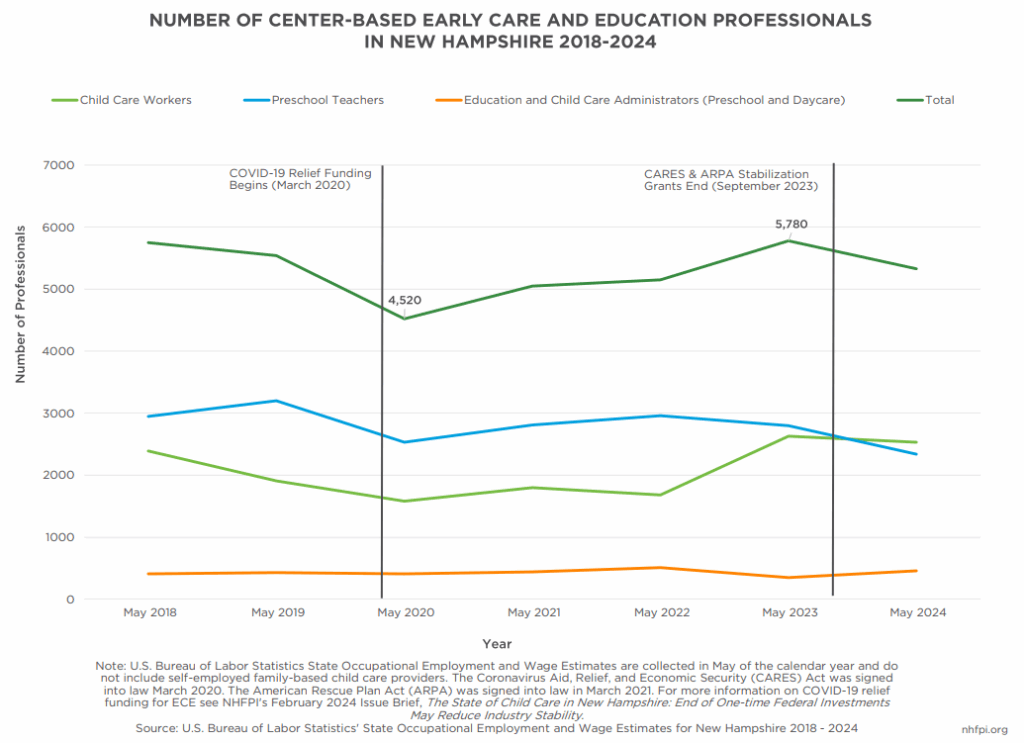New Hampshire's Early Childhood Care and Education (ECE) Workforce Shrank Between 2023 and 2024
- The ECE center-based workforce experienced an approximately 8 percent reduction in the number of individuals employed in the New Hampshire ECE workforce between 2023 and 2024, despite the Granite State workforce experiencing a net increase of approximately 1 percent during the same period, according to the U.S. Bureau of Labor Statistics (BLS).[1]
- A recent analysis from the University of New Hampshire’s Carsey School of Public Policy found Granite State family-based child care providers experienced a relatively larger closure rate between 2023 and 2024 (12.3 percent) than ECE center-based providers (2.8 percent), suggesting the ECE workforce reduction may be larger than the BLS estimates indicate.
ECE Professionals Did Not Earn Living Wages in 2024
- In 2024, ECE professionals categorized as “child care workers” earned a median annual salary of $34,570, over $2,000 more per year than in 2023. Hourly wages for these professionals increased to $16.62 per hour, $1.00 per hour more than in 2023.[2]
- Preschool teachers earned a median annual salary of $37,500, which was an estimated annual decrease of $150.00 between 2023 and 2024.[3]
- According to the Massachusetts Institute of Technology’s Living Wage Calculator, a single Granite State adult without children would need to earn $51,552 annually before taxes to support themselves. A single adult with one child would need to earn $93,451 while two working adults with one child would need to earn $104,373. These estimates do not include money set aside for emergency savings, retirement, or paying off student loan debt.
Child Care Remains Unaffordable for Most Granite State Families
- Between 2022 and 2024, tuition for an infant and four-year-old in center-based care in New Hampshire averaged nearly $30,000 annually ($29,763).[4]
- Among families with children under 18 years old between 2019 and 2023, this equated to approximately 19.6 percent of a median-earning married couple’s income ($152,054), 40.6 percent of a median earning single father’s income ($73,233), and 60 percent of a median earning single mother’s income ($49,587).[5]
The federal government set an affordability benchmark of seven percent of household income for child care.[6]
Economic Impact of Child Care Affordability and Availability Challenges
- During 2024, an average of approximately 17,300 Granite Staters reported being out of the labor force each month because they cared for children who were not in a school or child care setting.[7]
- In 2023, every unavailable child care slot may have cost the state’s economy as much as $35,000 in lost earnings to families and in forgone revenues to businesses as well as to the State and local governments.[8]
Endnotes
[1] See U.S. Bureau of Labor Statistics Occupational Employment and Wage Statistics (OEWS) Tables for New Hampshire from May 2018 to May 2024.
[2] See U.S. Bureau of Labor Statistics Occupational Employment and Wage Statistics for New Hampshire for May 2024 and NHFPI’s January 2025 factsheet, High Prices and Low Availability of Child Care in New Hampshire: Challenges Continue in 2025. Note: U.S. Bureau of Labor Statistics Occupational Employment and Wage Statistics are employer-reported. These numbers do not capture the wages of self-employed individuals who run family child care businesses.
[3] See U.S. Bureau of Labor Statistics Occupational Employment and Wage Statistics for New Hampshire for May 2024.
[4] Note: The average of tuition rates from 2022, 2023, and 2024 was used in these calculations because the 2024 Child Care Aware of America fact sheet for New Hampshire derived tuition averages from New Hampshire’s 2024 Child Care Market Rate Survey. The 2024 Child Care Market Rate survey had responses from about half of New Hampshire’s ECE providers and, as a result, may not have fully captured the range of possible tuition rates across the state. New Hampshire’s 2021 Child Care Market Rate survey had a final response rate of over 66 percent, which is above the 65 percent response rate required by the National Center on Subsidy Innovation and Accountability to ensure representative samples and statistical validity of the survey’s results. Child Care Aware of America uses estimates and projections in years when market rate surveys are not administered. Averaging across the Child Care Aware of America estimates may provide a more accurate picture of tuition rates in New Hampshire.
[5] See U.S. Census Bureau’s American Community Survey Five-Year Estimates for Median Income in the Past 12 Months.
[6] See p. 3 of September 30, 2016 U.S. Department of Health and Human Services Administration for Children and Families Office of Child Care Final Rule in Rules and Regulations.
[7] See U.S. Census Bureau’s Household Pulse Survey, January 9 through September 16 Table 3. Educational Attainment for Adults Not Working at Time of Survey, By Main Reason for Not Working and Source Used to Meet Spending Needs.
[8] See NHFPI’s February 2025 Issue Brief, The Economic Impact of the Granite State’s Child Care Shortage.


